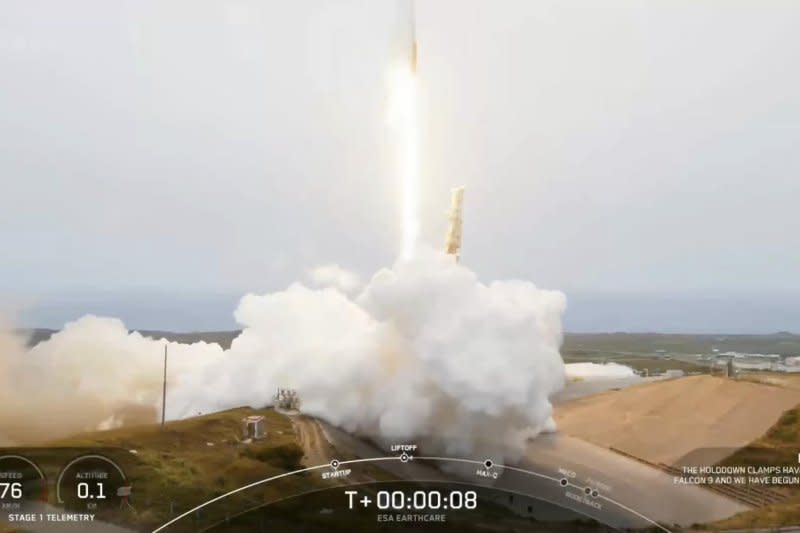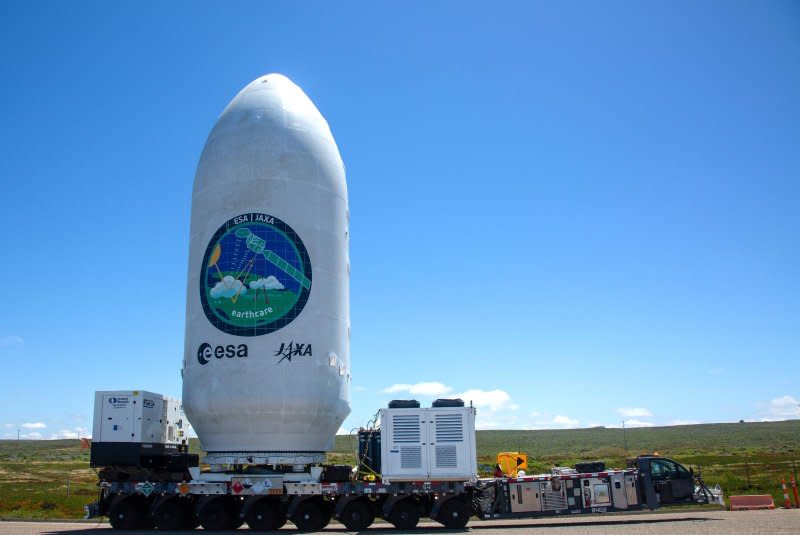SpaceX launches ESA's EarthCARE satellite to observe clouds, aerosols

May 28 (UPI) -- SpaceX launched a European Space Agency Earth observation satellite into orbit from California's Vandenberg Space Force Base on Tuesday to study the role of clouds and aerosols on climate and understand "our beautiful and fragile Earth so we can protect it."
The Earth Cloud Aerosol and Radiation Explorer, or EarthCARE, blasted off promptly at 6:20 p.m. EDT under cloudy California clouds, carrying the EarthCARE satellite that will examine clouds and aerosols in the atmosphere in an effort to "revolutionize our understanding" of how they impact Earth's climate, according to the ESA.
"Liftoff of ESA EO's EarthCARE!" SpaceX wrote in a post right after Tuesday's launch.
Liftoff of @ESA_EO's EarthCARE! pic.twitter.com/8vHR3Iy1AA— SpaceX (@SpaceX) May 28, 2024

Stage separation was confirmed just over two minutes after liftoff with dramatic video of Falcon 9's first stage falling back toward Earth.
Stage separation confirmed pic.twitter.com/NtCpdre2te— SpaceX (@SpaceX) May 28, 2024
Falcon 9's first stage landed at Vandenburg Air Force Base's Landing Zone 4 less than 9 minutes after liftoff. It is the booster's "seventh launch and landing," SpaceX wrote in a post on X.
Falcon 9's first stage has landed on Landing Zone 4 - completing this booster's seventh launch and landing pic.twitter.com/hx08G2nNIF— SpaceX (@SpaceX) May 28, 2024
Just over 10 minutes into the launch, the EarthCARE satellite payload was deployed.
Deployment of @ESA_EO's EarthCARE confirmed pic.twitter.com/URiwc3IzUd— SpaceX (@SpaceX) May 28, 2024
"It was an emotional moment for those of us here in Vandenberg who were able to bid farewell to our precious satellite while we watched it being encapsulated within the two halves of the rocket fairing, as it will never be 'seen' again by human eyes," Dirk Bernaerts, EarthCARE's project manager, said before Tuesday's launch.
"Of course, our real goodbyes will come when we see EarthCARE take to the skies."
The radiation explorer satellite will be used to determine how clouds and aerosols affect Earth's energy balance. While scientists know clouds and aerosols regulate our atmosphere's temperature, the satellite will help them determine how clouds and aerosols could change as Earth's climate warms.
"Tonight's launch is not only about exploring distant planets and galaxies, it is about understanding our beautiful and fragile Earth so we can protect it and improve life on our home planet," said ESA Director General Josef Aschbacher.
EarthCARE has taken the long road to get to space. The satellite was supposed to leave on a Russian Soyuz rocket and signed a deal with Arianespace in 2019 to make that happen. ESA shifted gears after Russia invaded Ukraine in 2022.
ESA hoped that the EarthCARE satellite could launch on a European Vega-C rocket but a static fire test paused those plans until at least late 2024. That led ESA to cross the Atlantic Ocean with new plans to allow SpaceX to send the satellite into space on one of its Falcon 9 rockets.
The Japan Aerospace Exploration Agency gave the ESA its Cloud Profiling Radar instrument to be added to EarthCARE along with data processing for it while orbiting the planet. The CPR and the ESA's Atmospheric Lidar will be the two active instruments on the satellite.

